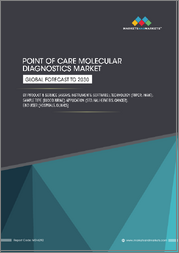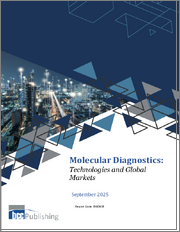
|
시장보고서
상품코드
1738266
세계의 분자 종양 진단 시장 - 산업 규모, 점유율, 동향, 경쟁, 기회, 예측 : 제품 유형별, 기술별, 용도별, 암 유형별, 최종 사용자별, 지역별 경쟁(2020-2030년)Molecular Oncology Diagnostics Market - Global Industry Size, Share, Trends, Competition, Opportunity, and Forecast, Segmented By Product Type, By Technology, By Application, By Cancer Type, By End User, By Region and Competition, 2020-2030F |
||||||
세계의 분자 종양 진단 시장 규모는 2024년에 35억 4,000만 달러로 평가되었고, 2030년에는 78억 4,000만 달러에 이를 것으로 예상되며, 예측 기간 중 CAGR은 14.17%를 나타낼 전망입니다.
만성 질환, 특히 암의 이환율이 증가함에 따라 시장이 급증하고 있으며, 이는 고급 진단 솔루션 수요를 촉진하고 있습니다. 검사를 가리키고 질병의 존재를 알리는 유전 물질, 단백질 및 바이오 마커를 확인합니다.이 접근법은 조기 발견, 표적 치료 및 환자 결과 개선을 지원합니다. 시퀸싱(NGS) 등 기술의 진보, 맞춤형 의료에 대한 투자 확대 등이 시장 성장에 기여하고 있습니다. 기술 혁신을 촉진하고 있습니다. 세계의 건강 관리 시스템이 조기 발견과 효율적인 질병 관리를 중시하고 있기 때문에 분자 종양 진단 시장은 선진국 및 신흥국 시장 전체에서 지속적인 확대가 전망되고 있습니다.
| 시장 개요 | |
|---|---|
| 예측 기간 | 2026-2030 |
| 시장 규모 : 2024년 | 35억 4,000만 달러 |
| 시장 규모 : 2030년 | 78억 4,000만 달러 |
| CAGR : 2025-2030년 | 14.17% |
| 급성장 부문 | 소프트웨어 |
| 최대 시장 | 북미 |
시장 성장 촉진요인
세계 암 이환율 상승과 조기 발견 수요 증가
주요 시장 과제
고비용 및 고도 진단 기술에 대한 액세스 제한
주요 시장 동향
분자진단에서 인공지능과 머신러닝의 통합
목차
제1장 개요
제2장 조사 방법
제3장 주요 요약
제4장 고객의 목소리
제5장 세계의 분자 종양 진단 시장 전망
- 시장 규모 및 예측
- 금액별
- 시장 점유율 및 예측
- 제품 유형별(기기, 키트 및 분석, 소프트웨어)
- 기술별(형광 in-situ Hybridization(FISH), 차세대 염기서열 분석(NGS), 중합효소 연쇄반응(PCR), 면역조직화학(IHC), 유세포 분석, 기타 기술)
- 용도별(연구, 임상)
- 암 유형별 {고형 종양(유방암, 난소암, 전립선암, 폐암, 대장암, 기타 고형 종양), 혈액암(림프종, 백혈병, 다발성 골수종, 기타 혈액 악성 종양)}
- 최종 사용자별(병원, 진단센터, 레퍼런스 랩, 제약 회사, 생명공학 회사, 학술 및 연구 기관)
- 지역별(북미, 유럽, 아시아태평양, 남미, 중동 및 아프리카)
- 기업별(2024년)
- 시장 맵
- 제품 유형별
- 기술별
- 용도별
- 암 유형별
- 최종 사용자별
- 지역별
제6장 북미의 분자 종양 진단 시장 전망
- 시장 규모 및 예측
- 시장 점유율 및 예측
- 북미 : 국가별 분석
- 미국
- 캐나다
- 멕시코
제7장 유럽의 분자 종양 진단 시장 전망
- 시장 규모 및 예측
- 시장 점유율 및 예측
- 유럽 : 국가별 분석
- 독일
- 프랑스
- 영국
- 이탈리아
- 스페인
제8장 아시아태평양의 분자 종양 진단 시장 전망
- 시장 규모 및 예측
- 시장 점유율 및 예측
- 아시아태평양 : 국가별 분석
- 중국
- 일본
- 인도
- 한국
- 호주
제9장 남미의 분자 종양 진단 시장 전망
- 시장 규모 및 예측
- 시장 점유율 및 예측
- 남미 : 국가별 분석
- 브라질
- 아르헨티나
- 콜롬비아
제10장 중동 및 아프리카의 분자 종양 진단 시장 전망
- 시장 규모 및 예측
- 시장 점유율 및 예측
- 중동 및 아프리카 : 국가별 분석
- 아랍에미리트(UAE)
- 사우디아라비아
- 남아프리카
제11장 시장 역학
- 성장 촉진요인
- 과제
제12장 시장 동향과 발전
- 합병과 인수
- 제품 출시
- 최근 동향
제13장 Porter's Five Forces 분석
- 업계 내 경쟁
- 신규 진입의 가능성
- 공급자의 협상력
- 고객의 협상력
- 대체품의 위협/서비스
제14장 세계의 분자 종양 진단 시장 : SWOT 분석
제15장 경쟁 구도
- Sysmex Corporation
- F. Hoffmann-La Roche Ltd.
- Myriad Genetics, Inc.
- HTG Molecular Diagnostics, Inc.
- Danaher Corporation
- QIAGEN NV
- Bio-Rad Laboratories, Inc.
- Agilent Technologies, Inc.
- Illumina, Inc.
- Bayer AG
제16장 전략적 제안
제17장 기업 소개와 면책사항
KTH 25.06.10The Global Molecular Oncology Diagnostics Market was valued at USD 3.54 billion in 2024 and is projected to reach USD 7.84 billion by 2030, growing at a CAGR of 14.17% during the forecast period. The market is expanding rapidly due to the rising incidence of chronic diseases, particularly cancer, which is driving the demand for advanced diagnostic solutions. Molecular oncology diagnostics refer to specialized tests used to detect cancer at the molecular level, identifying genetic materials, proteins, and biomarkers that signal the presence of disease. This approach supports early detection, targeted therapy, and improved patient outcomes. Increased awareness, advances in technology such as next-generation sequencing (NGS), and growing investments in personalized medicine are all contributing to market growth. In addition, stringent regulatory frameworks and a global shift toward precision oncology are encouraging innovation in molecular diagnostic platforms. As healthcare systems worldwide emphasize early detection and efficient disease management, the molecular oncology diagnostics market is poised for sustained expansion across developed and emerging regions.
| Market Overview | |
|---|---|
| Forecast Period | 2026-2030 |
| Market Size 2024 | USD 3.54 Billion |
| Market Size 2030 | USD 7.84 Billion |
| CAGR 2025-2030 | 14.17% |
| Fastest Growing Segment | Software |
| Largest Market | North America |
Key Market Drivers
Increasing Global Cancer Incidence and Demand for Early Detection
The rising global prevalence of cancer is a major factor propelling growth in the molecular oncology diagnostics market. According to the World Health Organization (WHO), nearly 10 million people died from cancer in 2020, with the incidence rate expected to rise by 47% by 2040, reaching over 28 million new cases annually. This alarming increase has led to a heightened focus on early detection and precision diagnostics to improve treatment outcomes and reduce healthcare burdens. Molecular diagnostics offer a pathway for identifying cancer-related mutations, chromosomal changes, and gene expression profiles even before clinical symptoms appear. Technologies like PCR, NGS, and microarrays are pivotal in enabling personalized treatment strategies and enhancing prognosis accuracy. Governments and research bodies are investing heavily in cancer diagnostics infrastructure; for example, the U.S. National Cancer Institute allocated over $7 billion in 2023 for cancer research, with a strong emphasis on molecular diagnostic tools. These developments underscore the growing importance of molecular oncology diagnostics in combating the global cancer burden.
Key Market Challenges
High Cost and Limited Accessibility of Advanced Diagnostic Technologies
Despite technological progress, the high cost of molecular oncology diagnostics remains a critical barrier to widespread adoption. Advanced testing methods like next-generation sequencing and multiplex PCR panels require expensive reagents, equipment, and skilled professionals, making them inaccessible in many low- and middle-income countries. A single NGS test can cost between $1,000 and $5,000, limiting affordability for patients and straining underfunded healthcare systems. Furthermore, insufficient diagnostic infrastructure, particularly in rural areas, exacerbates disparities in healthcare access. Challenges include a lack of molecular pathology labs, inadequate cold chain systems, and a shortage of trained personnel. Even in developed nations, inconsistent reimbursement policies hinder the adoption of newer molecular tests. According to the World Bank, healthcare expenditure in low-income nations averages about 5% of GDP, compared to more than 10% in high-income countries. This disparity underscores the urgent need for policy support, public-private partnerships, and cost-reduction strategies to bridge the accessibility gap in molecular diagnostics.
Key Market Trends
Integration of Artificial Intelligence and Machine Learning in Molecular Diagnostics
A transformative trend in the molecular oncology diagnostics market is the integration of artificial intelligence (AI) and machine learning (ML) technologies to streamline and enhance genomic data analysis. As diagnostic platforms generate increasingly complex datasets, AI and ML provide tools to analyze patterns, classify cancer subtypes, and predict patient responses more accurately and rapidly than manual methods. These technologies can process thousands of variants simultaneously, identifying clinically relevant mutations and helping in treatment selection. Deep learning models are also being used to enhance the accuracy of image-based diagnostics and to interpret multi-omics data in real-time. Governments are supporting AI development through major funding initiatives, such as the NIH's Bridge2AI program in the U.S. and the UK's Industrial Strategy Challenge Fund. These efforts are catalyzing the adoption of AI-driven diagnostics, making molecular oncology testing more efficient, scalable, and accessible across the globe.
Key Market Players
- Sysmex Corporation
- F. Hoffmann-La Roche Ltd.
- Myriad Genetics, Inc.
- HTG Molecular Diagnostics, Inc.
- Danaher Corporation
- QIAGEN N.V.
- Bio-Rad Laboratories, Inc.
- Agilent Technologies, Inc.
- Illumina, Inc.
- Bayer AG
Report Scope:
In this report, the Global Molecular Oncology Diagnostics Market has been segmented into the following categories, in addition to the industry trends which have also been detailed below:
Molecular Oncology Diagnostics Market, By Product Type:
- Instruments
- Kits and Assays
- Software
Molecular Oncology Diagnostics Market, By Technology:
- Fluorescence In-Situ Hybridization (FISH)
- Next-Generation Sequencing (NGS)
- Polymerase Chain Reaction (PCR)
- Immunohistochemistry (IHC)
- Flow Cytometry
- Other Technologies
Molecular Oncology Diagnostics Market, By Application:
- Research
- Clinical
Molecular Oncology Diagnostics Market, By Cancer Type:
- Solid Tumor (Breast Cancer, Ovarian Cancer, Prostate Cancer, Lung Cancer, Colorectal Cancer, and Other Solid Tumors)
- Blood Cancers (Lymphoma, Leukemia, Multiple Myeloma, and other Hematological Malignancies)
Molecular Oncology Diagnostics Market, By End User:
- Hospitals and Diagnostic Centers
- Reference Laboratories
- Pharmaceutical and Biotechnology Companies
- Academic and Research Institutes
Molecular Oncology Diagnostics Market, By Region:
- North America
- United States
- Mexico
- Canada
- Europe
- France
- Germany
- United Kingdom
- Italy
- Spain
- Asia-Pacific
- China
- India
- South Korea
- Japan
- Australia
- South America
- Brazil
- Argentina
- Colombia
- Middle East and Africa
- South Africa
- Saudi Arabia
- UAE
Competitive Landscape
Company Profiles: Detailed analysis of the major companies present in the Global Molecular Oncology Diagnostics Market.
Available Customizations:
Global Molecular Oncology Diagnostics Market report with the given market data, TechSci Research offers customizations according to a company's specific needs. The following customization options are available for the report:
Company Information
- Detailed analysis and profiling of additional market players (up to five).
Table of Contents
1. Product Overview
- 1.1. Market Definition
- 1.2. Scope of the Market
- 1.2.1. Markets Covered
- 1.2.2. Years Considered for Study
- 1.2.3. Key Market Segmentations
2. Research Methodology
- 2.1. Objective of the Study
- 2.2. Baseline Methodology
- 2.3. Key Industry Partners
- 2.4. Major Association and Secondary Sources
- 2.5. Forecasting Methodology
- 2.6. Data Triangulation & Validation
- 2.7. Assumptions and Limitations
3. Executive Summary
- 3.1. Overview of the Market
- 3.2. Overview of Key Market Segmentations
- 3.3. Overview of Key Market Players
- 3.4. Overview of Key Regions/Countries
- 3.5. Overview of Market Drivers, Challenges, Trends
4. Voice of Customer
5. Global Molecular Oncology Diagnostics Market Outlook
- 5.1. Market Size & Forecast
- 5.1.1. By Value
- 5.2. Market Share & Forecast
- 5.2.1. By Product Type (Instruments, Kits and Assays, Software)
- 5.2.2. By Technology (Fluorescence In-Situ Hybridization (FISH), Next-Generation Sequencing (NGS), Polymerase Chain Reaction (PCR), Immunohistochemistry (IHC), Flow Cytometry, and Other Technologies)
- 5.2.3. By Application (Research, Clinical)
- 5.2.4. By Cancer Type {Solid Tumor (Breast Cancer, Ovarian Cancer, Prostate Cancer, Lung Cancer, Colorectal Cancer, and Other Solid Tumors), Blood cancers (Lymphoma, Leukemia, Multiple Myeloma, and other Hematological Malignancies)}
- 5.2.5. By End User (Hospitals and Diagnostic Centers, Reference Laboratories, Pharmaceutical and Biotechnology Companies, Academic and Research Institutes)
- 5.2.6. By Region (North America, Europe, Asia Pacific, South America, Middle East, and Africa)
- 5.2.7. By Company (2024)
- 5.3. Market Map
- 5.3.1. By Product Type
- 5.3.2. By Technology
- 5.3.3. By Application
- 5.3.4. By Cancer Type
- 5.3.5. By End User
- 5.3.6. By Region
6. North America Molecular Oncology Diagnostics Market Outlook
- 6.1. Market Size & Forecast
- 6.1.1. By Value
- 6.2. Market Share & Forecast
- 6.2.1. By Product Type
- 6.2.2. By Technology
- 6.2.3. By Application
- 6.2.4. By Cancer Type
- 6.2.5. By End User
- 6.2.6. By Country
- 6.3. North America: Country Analysis
- 6.3.1. United States Molecular Oncology Diagnostics Market Outlook
- 6.3.1.1. Market Size & Forecast
- 6.3.1.1.1. By Value
- 6.3.1.2. Market Share & Forecast
- 6.3.1.2.1. By Product Type
- 6.3.1.2.2. By Technology
- 6.3.1.2.3. By Application
- 6.3.1.2.4. By Cancer Type
- 6.3.1.2.5. By End User
- 6.3.1.1. Market Size & Forecast
- 6.3.2. Canada Molecular Oncology Diagnostics Market Outlook
- 6.3.2.1. Market Size & Forecast
- 6.3.2.1.1. By Value
- 6.3.2.2. Market Share & Forecast
- 6.3.2.2.1. By Product Type
- 6.3.2.2.2. By Technology
- 6.3.2.2.3. By Application
- 6.3.2.2.4. By Cancer Type
- 6.3.2.2.5. By End User
- 6.3.2.1. Market Size & Forecast
- 6.3.3. Mexico Molecular Oncology Diagnostics Market Outlook
- 6.3.3.1. Market Size & Forecast
- 6.3.3.1.1. By Value
- 6.3.3.2. Market Share & Forecast
- 6.3.3.2.1. By Product Type
- 6.3.3.2.2. By Technology
- 6.3.3.2.3. By Application
- 6.3.3.2.4. By Cancer Type
- 6.3.3.2.5. By End User
- 6.3.3.1. Market Size & Forecast
- 6.3.1. United States Molecular Oncology Diagnostics Market Outlook
7. Europe Molecular Oncology Diagnostics Market Outlook
- 7.1. Market Size & Forecast
- 7.1.1. By Value
- 7.2. Market Share & Forecast
- 7.2.1. By Product Type
- 7.2.2. By Technology
- 7.2.3. By Application
- 7.2.4. By Cancer Type
- 7.2.5. By End User
- 7.2.6. By Country
- 7.3. Europe: Country Analysis
- 7.3.1. Germany Molecular Oncology Diagnostics Market Outlook
- 7.3.1.1. Market Size & Forecast
- 7.3.1.1.1. By Value
- 7.3.1.2. Market Share & Forecast
- 7.3.1.2.1. By Product Type
- 7.3.1.2.2. By Technology
- 7.3.1.2.3. By Application
- 7.3.1.2.4. By Cancer Type
- 7.3.1.2.5. By End User
- 7.3.1.1. Market Size & Forecast
- 7.3.2. France Molecular Oncology Diagnostics Market Outlook
- 7.3.2.1. Market Size & Forecast
- 7.3.2.1.1. By Value
- 7.3.2.2. Market Share & Forecast
- 7.3.2.2.1. By Product Type
- 7.3.2.2.2. By Technology
- 7.3.2.2.3. By Application
- 7.3.2.2.4. By Cancer Type
- 7.3.2.2.5. By End User
- 7.3.2.1. Market Size & Forecast
- 7.3.3. United Kingdom Molecular Oncology Diagnostics Market Outlook
- 7.3.3.1. Market Size & Forecast
- 7.3.3.1.1. By Value
- 7.3.3.2. Market Share & Forecast
- 7.3.3.2.1. By Product Type
- 7.3.3.2.2. By Technology
- 7.3.3.2.3. By Application
- 7.3.3.2.4. By Cancer Type
- 7.3.3.2.5. By End User
- 7.3.3.1. Market Size & Forecast
- 7.3.4. Italy Molecular Oncology Diagnostics Market Outlook
- 7.3.4.1. Market Size & Forecast
- 7.3.4.1.1. By Value
- 7.3.4.2. Market Share & Forecast
- 7.3.4.2.1. By Product Type
- 7.3.4.2.2. By Technology
- 7.3.4.2.3. By Application
- 7.3.4.2.4. By Cancer Type
- 7.3.4.2.5. By End User
- 7.3.4.1. Market Size & Forecast
- 7.3.5. Spain Molecular Oncology Diagnostics Market Outlook
- 7.3.5.1. Market Size & Forecast
- 7.3.5.1.1. By Value
- 7.3.5.2. Market Share & Forecast
- 7.3.5.2.1. By Product Type
- 7.3.5.2.2. By Technology
- 7.3.5.2.3. By Application
- 7.3.5.2.4. By Cancer Type
- 7.3.5.2.5. By End User
- 7.3.5.1. Market Size & Forecast
- 7.3.1. Germany Molecular Oncology Diagnostics Market Outlook
8. Asia-Pacific Molecular Oncology Diagnostics Market Outlook
- 8.1. Market Size & Forecast
- 8.1.1. By Value
- 8.2. Market Share & Forecast
- 8.2.1. By Product Type
- 8.2.2. By Technology
- 8.2.3. By Application
- 8.2.4. By Cancer Type
- 8.2.5. By End User
- 8.2.6. By Country
- 8.3. Asia-Pacific: Country Analysis
- 8.3.1. China Molecular Oncology Diagnostics Market Outlook
- 8.3.1.1. Market Size & Forecast
- 8.3.1.1.1. By Value
- 8.3.1.2. Market Share & Forecast
- 8.3.1.2.1. By Product Type
- 8.3.1.2.2. By Technology
- 8.3.1.2.3. By Application
- 8.3.1.2.4. By Cancer Type
- 8.3.1.2.5. By End User
- 8.3.1.1. Market Size & Forecast
- 8.3.2. Japan Molecular Oncology Diagnostics Market Outlook
- 8.3.2.1. Market Size & Forecast
- 8.3.2.1.1. By Value
- 8.3.2.2. Market Share & Forecast
- 8.3.2.2.1. By Product Type
- 8.3.2.2.2. By Technology
- 8.3.2.2.3. By Application
- 8.3.2.2.4. By Cancer Type
- 8.3.2.2.5. By End User
- 8.3.2.1. Market Size & Forecast
- 8.3.3. India Molecular Oncology Diagnostics Market Outlook
- 8.3.3.1. Market Size & Forecast
- 8.3.3.1.1. By Value
- 8.3.3.2. Market Share & Forecast
- 8.3.3.2.1. By Product Type
- 8.3.3.2.2. By Technology
- 8.3.3.2.3. By Application
- 8.3.3.2.4. By Cancer Type
- 8.3.3.2.5. By End User
- 8.3.3.1. Market Size & Forecast
- 8.3.4. South Korea Molecular Oncology Diagnostics Market Outlook
- 8.3.4.1. Market Size & Forecast
- 8.3.4.1.1. By Value
- 8.3.4.2. Market Share & Forecast
- 8.3.4.2.1. By Product Type
- 8.3.4.2.2. By Technology
- 8.3.4.2.3. By Application
- 8.3.4.2.4. By Cancer Type
- 8.3.4.2.5. By End User
- 8.3.4.1. Market Size & Forecast
- 8.3.5. Australia Molecular Oncology Diagnostics Market Outlook
- 8.3.5.1. Market Size & Forecast
- 8.3.5.1.1. By Value
- 8.3.5.2. Market Share & Forecast
- 8.3.5.2.1. By Product Type
- 8.3.5.2.2. By Technology
- 8.3.5.2.3. By Application
- 8.3.5.2.4. By Cancer Type
- 8.3.5.2.5. By End User
- 8.3.5.1. Market Size & Forecast
- 8.3.1. China Molecular Oncology Diagnostics Market Outlook
9. South America Molecular Oncology Diagnostics Market Outlook
- 9.1. Market Size & Forecast
- 9.1.1. By Value
- 9.2. Market Share & Forecast
- 9.2.1. By Product Type
- 9.2.2. By Technology
- 9.2.3. By Application
- 9.2.4. By Cancer Type
- 9.2.5. By End User
- 9.2.6. By Country
- 9.3. South America: Country Analysis
- 9.3.1. Brazil Molecular Oncology Diagnostics Market Outlook
- 9.3.1.1. Market Size & Forecast
- 9.3.1.1.1. By Value
- 9.3.1.2. Market Share & Forecast
- 9.3.1.2.1. By Product Type
- 9.3.1.2.2. By Technology
- 9.3.1.2.3. By Application
- 9.3.1.2.4. By Cancer Type
- 9.3.1.2.5. By End User
- 9.3.1.1. Market Size & Forecast
- 9.3.2. Argentina Molecular Oncology Diagnostics Market Outlook
- 9.3.2.1. Market Size & Forecast
- 9.3.2.1.1. By Value
- 9.3.2.2. Market Share & Forecast
- 9.3.2.2.1. By Product Type
- 9.3.2.2.2. By Technology
- 9.3.2.2.3. By Application
- 9.3.2.2.4. By Cancer Type
- 9.3.2.2.5. By End User
- 9.3.2.1. Market Size & Forecast
- 9.3.3. Colombia Molecular Oncology Diagnostics Market Outlook
- 9.3.3.1. Market Size & Forecast
- 9.3.3.1.1. By Value
- 9.3.3.2. Market Share & Forecast
- 9.3.3.2.1. By Product Type
- 9.3.3.2.2. By Technology
- 9.3.3.2.3. By Application
- 9.3.3.2.4. By Cancer Type
- 9.3.3.2.5. By End User
- 9.3.3.1. Market Size & Forecast
- 9.3.1. Brazil Molecular Oncology Diagnostics Market Outlook
10. Middle East and Africa Molecular Oncology Diagnostics Market Outlook
- 10.1. Market Size & Forecast
- 10.1.1. By Value
- 10.2. Market Share & Forecast
- 10.2.1. By Product Type
- 10.2.2. By Technology
- 10.2.3. By Application
- 10.2.4. By Cancer Type
- 10.2.5. By End User
- 10.2.6. By Country
- 10.3. MEA: Country Analysis
- 10.3.1. UAE Molecular Oncology Diagnostics Market Outlook
- 10.3.1.1. Market Size & Forecast
- 10.3.1.1.1. By Value
- 10.3.1.2. Market Share & Forecast
- 10.3.1.2.1. By Product Type
- 10.3.1.2.2. By Technology
- 10.3.1.2.3. By Application
- 10.3.1.2.4. By Cancer Type
- 10.3.1.2.5. By End User
- 10.3.1.1. Market Size & Forecast
- 10.3.2. Saudi Arabia Molecular Oncology Diagnostics Market Outlook
- 10.3.2.1. Market Size & Forecast
- 10.3.2.1.1. By Value
- 10.3.2.2. Market Share & Forecast
- 10.3.2.2.1. By Product Type
- 10.3.2.2.2. By Technology
- 10.3.2.2.3. By Application
- 10.3.2.2.4. By Cancer Type
- 10.3.2.2.5. By End User
- 10.3.2.1. Market Size & Forecast
- 10.3.3. South Africa Molecular Oncology Diagnostics Market Outlook
- 10.3.3.1. Market Size & Forecast
- 10.3.3.1.1. By Value
- 10.3.3.2. Market Share & Forecast
- 10.3.3.2.1. By Product Type
- 10.3.3.2.2. By Technology
- 10.3.3.2.3. By Application
- 10.3.3.2.4. By Cancer Type
- 10.3.3.2.5. By End User
- 10.3.3.1. Market Size & Forecast
- 10.3.1. UAE Molecular Oncology Diagnostics Market Outlook
11. Market Dynamics
- 11.1. Drivers
- 11.2. Challenges
12. Market Trends & Developments
- 12.1. Merger & Acquisition (If Any)
- 12.2. Product Launches (If Any)
- 12.3. Recent Developments
13. Porters Five Forces Analysis
- 13.1. Competition in the Industry
- 13.2. Potential of New Entrants
- 13.3. Power of Suppliers
- 13.4. Power of Customers
- 13.5. Threat of Substitute Products/Services
14. Global Molecular Oncology Diagnostics Market: SWOT Analysis
15. Competitive Landscape
- 15.1. Sysmex Corporation
- 15.1.1. Business Overview
- 15.1.2. Company Snapshot
- 15.1.3. Products & Services
- 15.1.4. Financials (As Reported)
- 15.1.5. Recent Developments
- 15.1.6. Key Personnel Details
- 15.1.7. SWOT Analysis
- 15.2. F. Hoffmann-La Roche Ltd.
- 15.3. Myriad Genetics, Inc.
- 15.4. HTG Molecular Diagnostics, Inc.
- 15.5. Danaher Corporation
- 15.6. QIAGEN N.V.
- 15.7. Bio-Rad Laboratories, Inc.
- 15.8. Agilent Technologies, Inc.
- 15.9. Illumina, Inc.
- 15.10. Bayer AG
16. Strategic Recommendations
17. About Us & Disclaimer
(주말 및 공휴일 제외)


















